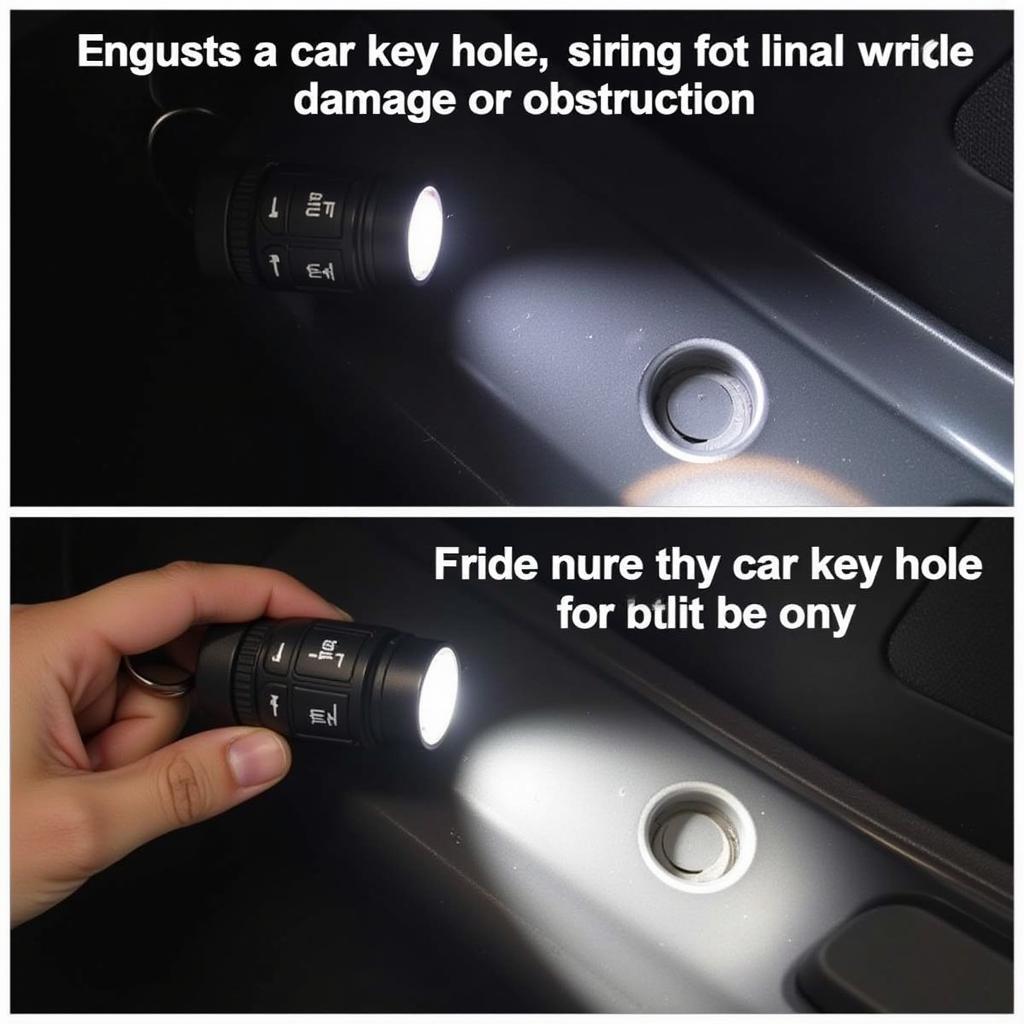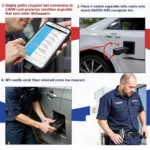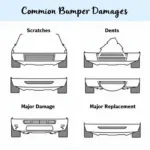A broken car key hole can be a frustrating experience, leaving you stranded and unsure of what to do. This article will guide you through the process of diagnosing and potentially fixing a broken car key hole, offering practical solutions and expert advice on how to repair broken car key hole issues. Let’s dive in and get you back on the road! See our guide on emergency car key repair for immediate assistance if you are locked out.
Common Causes of a Broken Car Key Hole
Before attempting a repair, understanding the underlying cause is crucial. Here are some common reasons why your car key hole might be broken:
- Worn out tumblers: Over time, the internal mechanisms of the lock cylinder, known as tumblers, can wear down, making it difficult for the key to engage properly.
- Foreign objects: Dirt, debris, or even broken key fragments lodged inside the key hole can obstruct the mechanism and prevent the key from turning.
- Bent or damaged key: A bent or damaged car key can also damage the delicate tumblers inside the lock cylinder, leading to a broken key hole.
- Freezing temperatures: In cold climates, moisture inside the lock cylinder can freeze, preventing the key from entering or turning.
- Vandalism or attempted theft: Forced entry attempts can damage the lock cylinder and render the key hole unusable.
Diagnosing the Problem
Accurately diagnosing the problem is the first step towards a successful repair. Try these steps:
- Inspect the key: Check your car key for any signs of bending, damage, or wear. A compromised key can exacerbate the issue.
- Check for obstructions: Carefully inspect the key hole for any visible debris or foreign objects. Use a flashlight to get a better view inside.
- Try a different key: If you have a spare car key, try using it to see if the problem lies with the key itself.
- Listen for unusual sounds: When inserting and turning the key, listen for any clicking, grinding, or other unusual sounds that could indicate internal damage.
 Diagnosing a Car Key Hole Problem
Diagnosing a Car Key Hole Problem
DIY Car Key Hole Repair Methods
For minor issues, you may be able to repair the car key hole yourself. Here are a few DIY methods:
- Using lubricant: Applying a graphite-based lubricant or WD-40 can help loosen stuck tumblers and dislodge debris. Avoid using oil-based lubricants as they can attract more dirt and gum up the mechanism. For more complex key issues, consider exploring mini car key repair.
- Removing debris: Use a compressed air canister or a thin, pointed object (like a paperclip) to carefully remove any visible debris from the key hole.
- Thawing a frozen lock: If the lock is frozen, try using a de-icer specifically designed for car locks. Avoid using hot water, as it can damage the lock mechanism.
- Repairing a broken key loop: If the problem lies with a broken key loop, you might be able to repair it using a strong adhesive or by replacing the key loop altogether. Check out our guide on how to fix car key broken key loop repair.
When to Call a Professional Locksmith
While some car key hole issues can be resolved with DIY methods, more complex problems require the expertise of a professional locksmith. If you’ve tried the above methods and the problem persists, or if you suspect internal damage to the lock cylinder, it’s best to seek professional help. A locksmith has the tools and knowledge to diagnose and repair even the most complex car key hole issues. You can also find helpful information on car key hole repair on our dedicated page.
Conclusion
A broken car key hole can be a major inconvenience, but with the right approach, you can often resolve the issue. By understanding the common causes, diagnosing the problem effectively, and applying the appropriate repair methods, you can get your car key working smoothly again. If the problem persists, however, don’t hesitate to contact a professional locksmith for assistance. Remember, a functioning car key hole is essential for your vehicle’s security and your peace of mind. Need help with a stuck key? Check out our article on car key stuck in ignition repair.
FAQ
- Can I use any lubricant for my car key hole? No, it’s best to use a graphite-based lubricant or WD-40. Avoid oil-based lubricants.
- What should I do if my key breaks inside the lock? Contact a professional locksmith immediately. Attempting to remove it yourself could cause further damage.
- How much does it cost to repair a broken car key hole? The cost varies depending on the extent of the damage and the type of vehicle.
- Can I prevent my car key hole from breaking? Regular maintenance, such as cleaning and lubricating the lock, can help prevent problems.
- What if my car key is bent? A bent key can damage the lock cylinder. Consider getting a replacement key made as soon as possible.
- Is it safe to use a de-icer on my car lock? Yes, but make sure it’s specifically designed for car locks.
- What if I suspect someone tried to break into my car? Contact the police and a locksmith to assess the damage and improve your car’s security.
Common Scenarios
- Key won’t turn: This could be due to a worn-out lock, a bent key, or a foreign object.
- Key stuck in the ignition: This often requires professional assistance. We have a dedicated page about car key stuck in ignition repair that you might find helpful.
- Key won’t go in: This suggests a blockage or a misaligned lock.
Further Assistance
For additional information, explore our guides on how to fix car key broken key loop repair and mini car key repair.
For immediate assistance, contact us via WhatsApp: +1(641)206-8880, Email: [email protected]. Our customer service team is available 24/7.


